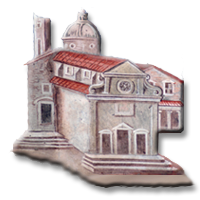Introduzione
St Augustine, dressed in monk’s clothing rather than his usual bishop’s attire, pauses from his writing of the rules of his Order which he later dispenses to the monks. Aurelius Augustinus, born at Tageste in Numidia (Tunisia) was Bishop of Hippo (near Annaba, Algeria) from around 396 after being baptised by Ambrose in 387. He was one of the Four Fathers of the Latin Church.
The painting was bought by William Bankes (1786–1855) in Spain in 1814, with a provenance from, according to him of ‘Philibert, Duke of Savoy’ - actually Emmanuel Philibert, Prince of Oneglia (1588-1624), son of the duke and ultimately Spanish Viceroy of Sicily), having been bequeathed by Bishop Lozano to the Cathedral at Plasencia, as by ‘Spagnolet’ (Jusepe Ribera) which he re-attributed to Murillo. He particularly admired: “a mellowness that is quite remarkable in a plain gray colour.”
attributed to Francisco de Zurbarán (Fuente de Cantos 1598 - Madrid 1664), artist
Spanish School, artist
previously catalogued as attributed to Bartolomé Esteban Murillo (Seville 1617 - Seville 1682), artist
previously catalogued as attributed to Jusepe de Ribera (Jativa 1591 – Margellina 1652), artist
fonte: http://www.nationaltrustcollections.org.uk/
Oil painting on canvas, Saint Augustine, Bishop of Hippo (354-430) in Meditation, attributed to Francisco de Zurbaran (1598-1664). A full-length, view of the saint, wearing a reddish-brown robe, seated at a table, right, on which lie three books, the top one opened, the saint rests the side of his head on his fisted left hand, his gaze is upward and inward, in his right hand he holds a pen which is poised above the open book. Background, grey-green.
St Augustine, Aurelius Augustinus, also known as Augustine of Hippo, born in Tagaste in Numidia (modern Tunisia), native of Roman North Africa was son of Patricus, a pagan Roman officer and St Monica. At 16 he left for Carthage, where he studied rhetoric in order to become a lawyer, this he abandoned in favour of literature, teaching and philosophy. He also abandoned Christianity, took a mistress, with whom he lived for 15 years, and in 372 became the father of a son called Adeonatus. In 383 he moved to Rome to teach rhetoric and the following year was appointed to the chair of rhetoric in Milan where he met Ambrose, bishop of Milan, who introduced him to Christian Neoplatonism and forced him to reconsider his lost faith. He battled between the desire for worldly happiness and success and the call of the holy life. The conflict is set out in his Confessions (400 AD). His spiritual certainty resolved he turned back to Christianity and was baptised on the day before Easter in 387 with his son Adeonatus. Later that same year he returned to Africa where he founded a community organised along semi-monastic lines, based on prayer and study, but also allowing for lively discussion. On a visit to hear Bishop Valerius speak in Hippo (in present-day Algeria; as Bône when under French rule, and as Annaba since Independence), he was offered up for ordination by the people. He was duly ordained and in 396 became Bishop of Hippo on the death of Valerius. He died in Hippo on 28 August 430 while the city was being besieged by Genseric’s Vandal army. His monumental 'The City of God' presents human history in terms of the conflict between the spiritual and the temporal, which will end in the triumph of the City of God, whose manifestation on earth is the church.
The painting was acquired in Spain by William John Bankes as by ‘Spagnolet’ / ‘Spagnoletto’ [=Ribera (1588- 1652)] whose career was actually spent in Italy. Bankes wrote a letter to his father from Cairo, September 3rd 1815: “The Spagnolet is quite of his best, it belonged to Philibert D.[uke] of Savoy [sic], and is out of the Cathedral of Placencia [sic]. Do not have it cleaned till I come, I am so afraid that they will play tricks with it and paint in the background which has a mellowness that is quite remarkable in a plain gray colour. I would not have it touched for the world.”



